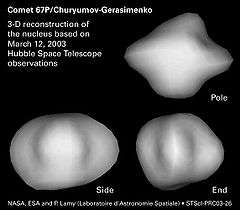MAVEN
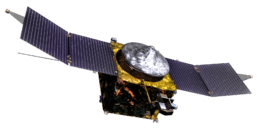 Artist's rendering of the MAVEN spacecraft bus | |||||
| Mission type | Mars atmospheric research | ||||
|---|---|---|---|---|---|
| Operator | NASA | ||||
| COSPAR ID | 2013-063A | ||||
| SATCAT № | 39378 | ||||
| Website | NASA MAVEN | ||||
| Mission duration |
1 Earth year.[1] Science phase extended through September 2016.[2] Additional 6 years as telecomm relay (planned).[2] | ||||
| Spacecraft properties | |||||
| Manufacturer |
Lockheed Martin CU-Boulder Berkeley NASA GSFC | ||||
| Launch mass | 2,454 kg (5,410 lb) | ||||
| Dry mass | 809 kg (1,784 lb) | ||||
| Payload mass | 65 kg (143 lb) | ||||
| Power | 1,135 watts[3] | ||||
| Start of mission | |||||
| Launch date | November 18, 2013, 18:28 UTC | ||||
| Rocket | Atlas V 401 AV-038 | ||||
| Launch site | Cape Canaveral SLC-41 | ||||
| Contractor | United Launch Alliance | ||||
| Orbital parameters | |||||
| Reference system | Areocentric (Mars) | ||||
| Periareion | 150 km (93 mi) | ||||
| Apoareion | 6,200 km (3,900 mi) | ||||
| Inclination | 75 degrees | ||||
| Period | 4.5 hours | ||||
| Epoch | Planned | ||||
| Mars orbiter | |||||
| Orbital insertion |
September 22, 2014, 02:24 UTC[4] MSD 50025 08:07 AMT | ||||
|
| |||||
Mars Atmosphere and Volatile EvolutioN Mission (MAVEN) is a space probe developed by NASA designed to study the Martian atmosphere while orbiting Mars. Mission goals include determining how the planet's atmosphere and water, presumed to have once been substantial, were lost over time.[4][5][6][7][8]
MAVEN was successfully launched aboard an Atlas V launch vehicle at the beginning of the first launch window on November 18, 2013. Following the first engine burn of the Centaur second stage, the vehicle coasted in low Earth orbit for 27 minutes before a second Centaur burn of five minutes to insert it into a heliocentric Mars transit orbit.
On September 22, 2014, MAVEN reached Mars and was inserted into an areocentric elliptic orbit 6,200 km (3,900 mi) by 150 km (93 mi) above the planet's surface. The principal investigator for the spacecraft is Bruce Jakosky of the Laboratory for Atmospheric and Space Physics at the University of Colorado Boulder.[4][5][9][10]
On 5 November 2015, NASA announced that data from MAVEN shows that the deterioration of Mars’ atmosphere increases significantly during solar storms. That loss of atmosphere to space likely played a key role in Mars' gradual shift from its carbon dioxide-dominated atmosphere - which had kept Mars relatively warm and allowed the planet to support liquid surface water - to the cold, arid planet seen today. This shift took place between about 4.2 to 3.7 billion years ago.[11][12]
History
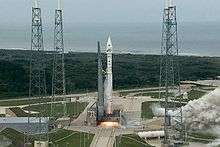
The mission was spawned by NASA's Mars Scout Program, which, although discontinued in 2010, yielded Phoenix, MAVEN, and numerous missions' studies.[13] Mars Scout missions target a cost of less than US$485 million, not including launch services, which cost approximately $187 million.[14] The total project costs up to $671 million.[15][16][17]
On September 15, 2008, NASA announced that it had selected MAVEN to be the Mars Scout 2013 mission.[1][18] There was one other finalist and eight other proposals that were competing against MAVEN. The name is a deliberate use of the word maven, "a person who has special knowledge or experience; an expert".[19][20]
On August 2, 2013, the MAVEN spacecraft arrived at Kennedy Space Center Florida to begin launch preparations.[21] NASA scheduled the launch of MAVEN from the Cape Canaveral Air Force Station on November 18, 2013, using an Atlas V 401 rocket.[22] The probe arrived in Mars orbit in September 2014, at approximately the same time as India's Mars Orbiter Mission.
On October 1, 2013, only seven weeks before launch, a government shutdown caused suspension of work for two days and initially threatened to force a 26-month postponement of the mission. With the spacecraft nominally scheduled to launch on November 18, a delay beyond December 7 would have caused MAVEN to miss the launch window as Mars moved too far out of alignment with the Earth.[23] However, two days later, a public announcement was made that NASA had deemed the 2013 MAVEN launch so essential to ensuring future communication with current NASA assets on Mars—the Opportunity and Curiosity rovers—that emergency funding was authorized to restart spacecraft processing in preparation for an on-time launch.[24][25]
On September 22, 2014, at approximately 2:24 UTC, MAVEN spacecraft entered orbit around Mars, completing an interplanetary journey of 10 months and 442 million miles (711 million kilometers).[26]
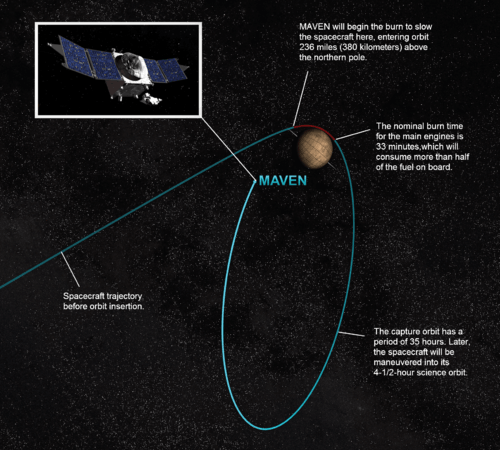
Objectives
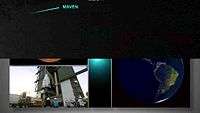
Features on Mars that resemble dry riverbeds and the discovery of minerals that form in the presence of water indicate that Mars once had a dense enough atmosphere and was warm enough for liquid water to flow on the surface. However, that thick atmosphere was somehow lost to space. Scientists suspect that over millions of years, Mars lost 99% of its atmosphere as the planet’s core cooled and its magnetic field decayed, allowing the solar wind to sweep away most of the water and volatile compounds that the atmosphere once contained.[27] The goal of MAVEN is to determine the history of the loss of atmospheric gases to space, providing answers about Martian climate evolution. By measuring the rate with which the atmosphere is currently escaping to space and gathering enough information about the relevant processes, scientists will be able to infer how the planet's atmosphere evolved over time. The MAVEN mission has four primary scientific objectives:
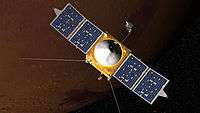
- Determine the role that loss of volatiles to space from the Martian atmosphere has played through time.
- Determine the current state of the upper atmosphere, ionosphere, and interactions with the solar wind.
- Determine the current rates of escape of neutral gases and ions to space and the processes controlling them.
- Determine the ratios of stable isotopes in the Martian atmosphere.[28]
MAVEN reached Mars and successfully maneuvered into orbit around the planet on September 21, 2014.[4] The Sample Analysis at Mars (SAM) instrument suite on board the Curiosity rover was scheduled to make similar surface measurements from Gale crater by that date. The data from Curiosity will help guide the interpretation of MAVEN's upper atmosphere measurements.[7] MAVEN's measurements will also provide additional scientific context with which to test models for current methane formation in Mars.[29]
Spacecraft overview
MAVEN was built and tested by Lockheed Martin Space Systems. Its design is based on those of the Mars Reconnaissance Orbiter and Mars Odyssey spacecraft. The orbiter has a cubical shape of about 2.3 meters × 2.3 meters × 2 meters high,[30] with two solar arrays that hold the magnetometers on both ends. The total length is 11.4 meters.[31]
Relay telecommunications

NASA's Jet Propulsion Laboratory provided an Electra ultra high frequency (UHF) relay radio payload[32][33] which has a data return rate of up to 2048 kbit/s.[34] The highly elliptical orbit of the MAVEN spacecraft may limit its usefulness as a relay for operating landers on the surface, although the long view periods of MAVEN's orbit have afforded some of the largest relay data returns to date of any Mars orbiter.[35][36][37] During the mission's first year of operations at Mars — the primary science phase — MAVEN served as a backup relay orbiter. Going forward into the extended mission for a period of up to ten years, MAVEN will provide UHF relay service for present and future Mars rovers and landers.[38]
Scientific instruments
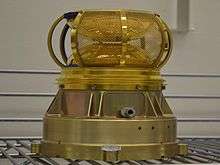
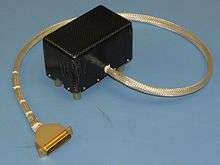

MAVEN will study Mars' upper atmosphere and its interactions with the solar wind. Its instruments will measure characteristics of Mars' atmospheric gases, upper atmosphere, ionosphere, and the solar wind.[39][40] MAVEN will perform measurements from a highly elliptical orbit over a period of one Earth year, with five "deep dips" at 150 km (93 mi) minimum altitude to sample the upper atmosphere.[41] The University of Colorado Boulder, University of California, Berkeley, and Goddard Space Flight Center each built a suite of instruments for the spacecraft, and they include:[42]
Particles and Field (P&F) Package:
- Built by the University of California, Berkeley Space Sciences Laboratory.
- Solar Wind Electron Analyzer (SWEA) – measures solar wind and ionosphere electrons
- Solar Wind Ion Analyzer (SWIA) – measures solar wind and magnetosheath ion density and velocity
- SupraThermal And Thermal Ion Composition (STATIC) – measures thermal ions to moderate-energy escaping ions
- Solar Energetic Particle (SEP) – determines the impact of SEPs on the upper atmosphere
- Langmuir Probe and Waves (LPW) – determines ionosphere properties and wave heating of escaping ions and solar extreme ultraviolet (EUV) input to atmosphere
- Magnetometer (MAG) – measures interplanetary solar wind and ionosphere magnetic fields[43]
Remote Sensing (RS) Package:
- Built by the University of Colorado Laboratory for Atmospheric and Space Physics.
- Imaging Ultraviolet Spectrometer (IUVS) – measures global characteristics of the upper atmosphere and ionosphere
Neutral Gas and Ion Mass Spectrometer (NGIMS) Package:
- Built by Goddard Space Flight Center
- Measures the composition and isotopes of neutral gases and ions
Status
The orbiter is in Mars orbit and operational. The commissioning phase lasted until the first week of November 2014 (six weeks), and then the science phase of the mission commenced.[44] In June 2015, the science phase was extended through September 2016.[2] MAVEN carries enough fuel to extend its science mission for an additional two years, and then another six years to function as a telecomm orbiter at a higher, more circular orbit.[2]
Results
On November 5, 2015 NASA scientists reported, based on results from the MAVEN orbiter circling Mars, that the solar wind is responsible for stripping away the atmosphere of Mars over the years, as the shielding effect of the global magnetic field was lost as the planet's internal dynamo cooled.[45][46]
Mars loses water into its thin atmosphere by evaporation. There, solar radiation can split the water molecules into their components, hydrogen and oxygen. The hydrogen, being the lightest element in the universe, then tends to rise far up to the highest levels of the Martian atmosphere, where several processes can strip it away into space, to be forever lost to the planet. This loss was thought to proceed at a fairly constant rate, but MAVEN's observations of Mars's atmospheric hydrogen through a full Martian year (almost two Earth years) show that the escape rate is highest when Mars's orbit brings it closest to the Sun, and only one-tenth as great when it is at its farthest.[48][49]
See also
References
- 1 2 "NASA - NASA Selects 'MAVEN' Mission to Study Mars Atmosphere". NASA.
- 1 2 3 4 "MAVEN - FAQ". University of Colorado. Retrieved 2016-04-06.
- ↑ 'MAVEN' Mission PowerPoint
- 1 2 3 4 Brown, Dwayne; Neal-Jones, Nancy; Zubritsky, Elizabeth (September 21, 2014). "NASA's Newest Mars Mission Spacecraft Enters Orbit around Red Planet". NASA. Retrieved September 22, 2014.
- 1 2 Chang, Kenneth (September 21, 2014). "NASA Craft, Nearing Mars, Prepares to Go to Work". New York Times. Retrieved September 21, 2014.
- ↑ Chang, Kenneth (November 15, 2013). "Probe May Help Solve Riddle of Mars's Missing Air". New York Times. Retrieved November 15, 2013.
- 1 2 New NASA Missions to Investigate How Mars Turned Hostile. By Bill Steigerwald (November 18, 2012)
- ↑ "Mars Atmosphere and Volatile EvolutioN Mission- Aerospace/Defense". FaceBook. Retrieved 28 September 2014.
- ↑ Hansen, Izumi; Zubritsky, Elizabeth (September 17, 2014). "NASA Mars Spacecraft Ready for Sept. 21 Orbit Insertion". NASA. Retrieved September 17, 2014.
- ↑ "NASA's MAVEN Spacecraft Makes Final Preparations For Mars". NASA.
- ↑ Northon, Karen (November 5, 2015). "NASA Mission Reveals Speed of Solar Wind Stripping Martian Atmosphere". NASA. Retrieved November 5, 2015.
- ↑ Wall, Mike (November 5, 2015). "Mars Lost Atmosphere to Space as Life Took Hold on Earth". Space.com. Retrieved November 6, 2015.
- ↑ Tudor Vieru (July 30, 2010). "NASA's Scout Program Discontinued". softpedia.
- ↑ NASA Awards Launch Services Contract for Maven Mission (October 21, 2010)
- ↑ Vergano, Dan (19 September 2014). "With NASA Probe's Arrival, International Mars Invasion Gets Under Way". National Geographic Magazine. Retrieved 24 September 2014.
- ↑ "NASA's Maven Craft Beats India's Mangalyaan in Space Race to Mars". WSJ. Retrieved 22 September 2014.
- ↑ "India Satellite Mangalyaan Reaches Mars Orbit on First Try". Wall Street Journal. Retrieved 24 September 2014.
- ↑ "Thumbs Up Given for 2013 NASA Mars Orbiter". October 5, 2010. Retrieved October 8, 2010.
- ↑ "NASA's MAVEN Mission @MAVEN2Mars". Twitter.com. Retrieved 7 March 2015.
Fittingly, from #Hebrew, via #Yiddish, a "maven" is a trusted expert who understands and seeks to pass knowledge on to others. #MAVEN #Mars
- ↑ American Heritage Dictionary of the English Language (4th ed.). Boston: Houghton Mifflin. 2000. p. 1082. ISBN 0-395-82517-2. Retrieved 7 March 2015.
A person who has special knowledge or experience; an expert.
- ↑ "NASA Begins Launch Preparations for Next Mars Mission". NASA. August 5, 2013. Retrieved August 6, 2013.
- ↑ "NASA Awards Launch Services Contract for MAVEN Mission". SpaceRef. Retrieved October 21, 2010.
- ↑ Elliott, Danielle (October 2, 2013). "Government shutdown could delay NASA's Mars MAVEN mission to 2017". CBS News. Retrieved October 3, 2013.
- ↑ Jakosky, Bruce (September 20, 2013). "MAVEN reactivation status update". Laboratory of Atmospheric and Space Physics. Retrieved October 4, 2013.
- ↑ Kerr, Richard A. (October 4, 2013). "Shutdown Won't Prevent NASA's MAVEN Mission From Lifting Off". Science Magazine. Retrieved October 4, 2013.
- ↑ "MAVEN Arrives at Mars". NASA. 21 September 2014. Retrieved 2014-09-26.
- ↑ MAVEN Mission to Investigate How Sun Steals Martian Atmosphere By Bill Steigerwald (October 5, 2010)
- ↑ MAVEN Fact Sheet
- ↑ "Mars Methane Questions Answered". Science channel. Retrieved November 14, 2009.
- ↑ MAVEN Mission Primary Structure Complete. NASA (September 26, 2011).
- ↑ MAVEN – Facts
- ↑ "MAVEN: Answers About Mars Climate History". NASA. 2012. Retrieved October 25, 2012.
- ↑ MAVEN - Mission Profile. Spaceflight 101.
- ↑ "The Electra Proximity Link Payload for Mars Relay Telecommunications and Navigation" (PDF). NASA. September 29, 2003. Retrieved January 11, 2013.
- ↑ Stephen, Clark (July 27, 2014). "NASA considers commercial telecom satellites at Mars". Space Flight Now. Retrieved 2014-09-23.
It is due to arrive at Mars in September, but MAVEN's planned orbit is not ideal for collecting and sending rover data.
- ↑ Newest NASA Mars Orbiter Demonstrates Relay Prowess. November 10, 2014.
- ↑ Chamberlain, Neil (2015-04-07). "Maven Relay Operations". 2015 IEEE Aerospace Conference. Program item 04.0402
- ↑ MAVEN - FAQ. NASA.
- ↑ Jha, Nupur (July 20, 2012). "Unique Instrument Devised to Solve Mars' Atmosphere Mystery". iDigital Times. Retrieved July 20, 2013.
- ↑ "CU chosen for $485M Mars exploration project". The VailDaily.
- ↑ Mission Timeline. University of Colorado Boulder.
- ↑ "MAVEN – Instruments". University of Colorado Boulder. 2012. Retrieved October 25, 2012.
- ↑ Neal-Jones, Nancy (May 21, 2012). "NASA Goddard Delivers Magnetometers for NASA's Next Mission to Mars". NASA.
- ↑ "NASA's Newest Mars Mission Spacecraft Enters Orbit around Red Planet". Science Daily. 22 September 2014. Retrieved 2014-09-24.
- ↑ Chang, Kenneth (November 5, 2015). "Solar Storms Strip Air From Mars, NASA Says". New York Times. Retrieved November 5, 2015.
- ↑ Staff (November 5, 2015). "VIDEO (51:58) - MAVEN - Measuring Mars' Atmospheric Loss". NASA. Retrieved November 5, 2015.
- ↑ Jones, Nancy; Steigerwald, Bill; Brown, Dwayne; Webster, Guy (October 14, 2014). "NASA Mission Provides Its First Look at Martian Upper Atmosphere". NASA. Retrieved October 15, 2014.
- ↑ "NASA's MAVEN Mission Observes Ups and Downs of Water Escape from Mars". Astrobiology Magazine. 2016-10-22. Retrieved 2016-10-23.
- ↑ Ang, Brian (2016-10-21). "NASA: MAVEN mission probes 'water-escaping' occurrences on Mars". HNGN. Retrieved 2016-10-23.
External links
| Look up Maven in Wiktionary, the free dictionary. |
| Wikimedia Commons has media related to MAVEN. |
- MAVEN – NASA
- MAVEN – JPL
- MAVEN – University of Colorado Boulder
- Integration of MAVEN Propellant Tank – NASA
- SpaceflightNow MAVEN mission status center
- Released results from MAVEN




.jpg)
.jpg)






